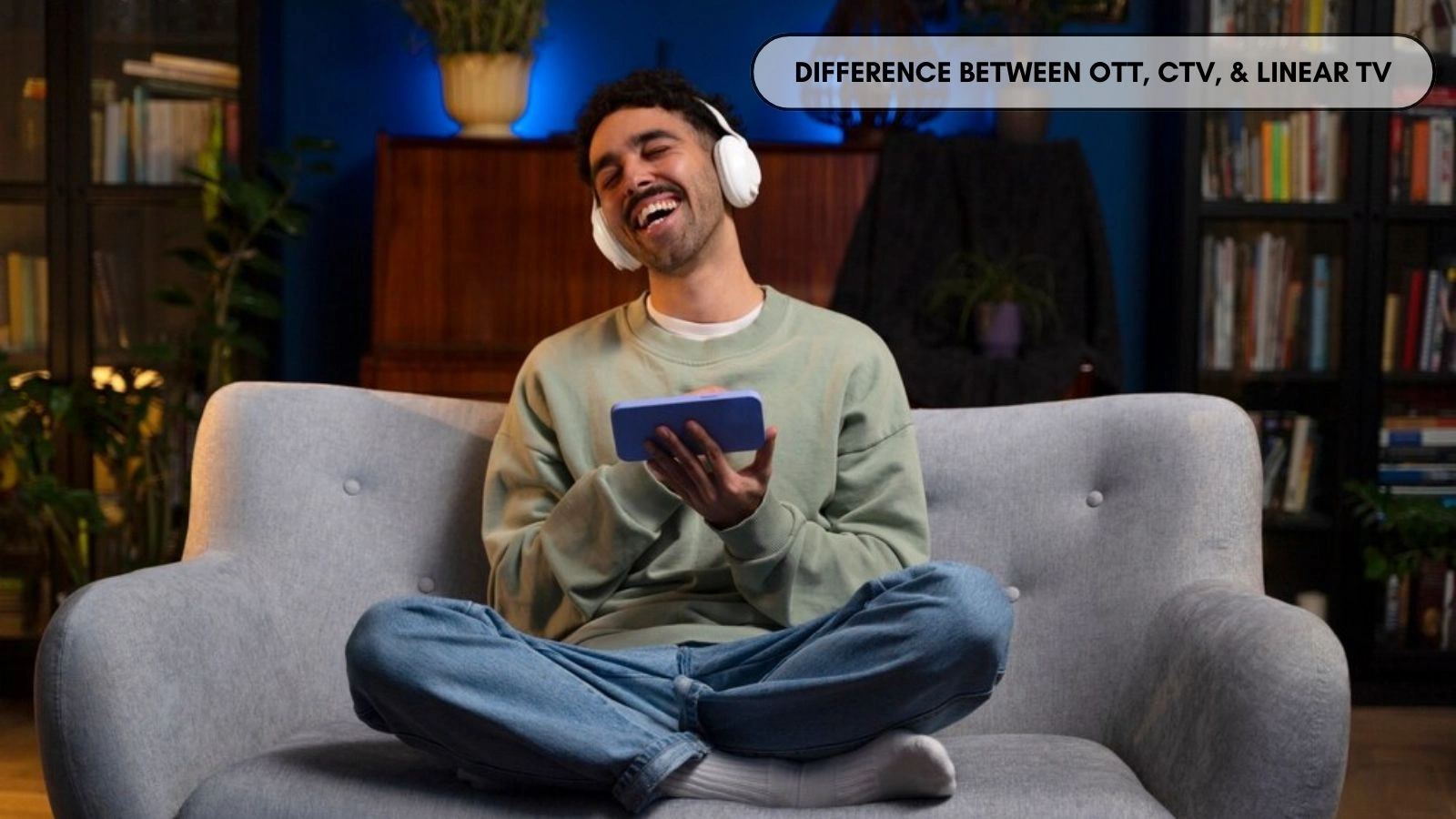How To Choose The Best OTT Advertising Platform For 2025?
In 2025, OTT advertising is set to be one of the most effective ways for brands to reach engagement. Advertising opportunities have exploded, with more people cutting the cord and shifting to streaming platforms. However, with so many OTT advertising companies and platforms, it can be overwhelming to figure out which is the best fit for your business.
In this guide, we will break down the essentials of OTT advertising, including what it is, how it differs from traditional TV and Connected TV (CTV), and why it’s essential for your marketing strategy in 2025.
You will also discover the top OTT platforms and the best OTT digital advertising companies to consider.
Let’s dive into how you can choose the right OTT advertising company and position your brand for success in 2025.
Keep reading and discover the tools and platforms that will make all the difference.
In a hurry? Listen to the blog instead!
What Is OTT?
OTT (Over-The-Top) refers to the delivery of television and video content via the Internet, bypassing traditional TV providers like cable or satellite. This allows viewers to access content on demand across various devices without needing a subscription to traditional TV services.
In simple terms, when viewers watch content on services like Netflix, Hulu, or Amazon Prime Video, they are engaging with an OTT platform.
What sets OTT apart is its flexibility; users can access content anytime, anywhere, across multiple devices like smartphones, tablets, smart TVs, and laptops. For brands and marketers, this means the ability to reach audiences in a far more personalized, targeted, and measurable way compared to traditional TV.
Unlike traditional media buying, OTT advertising offers granular targeting based on user behavior, interests, demographics, and even real-time location.
This precision gives brands more control over their advertising spend while achieving a deeper connection with their audience.
As OTT consumption continues to grow year over year, understanding its mechanics is not just beneficial, brands need to maintain relevance and drive growth in 2025 and beyond.
What Is OTT Advertising?
OTT advertising refers to delivering video ads directly to viewers over streaming platforms, avoiding traditional cable and satellite TV providers. Instead of broad, generalized ad placements, OTT allows brands to target specific audiences based on data like demographics, interests, location, and even viewing habits.
How does it work?
When users stream content on an OTT platform, whether it’s a show, movie, or live event, ads are served during or between the content, much like traditional TV commercials. However, the difference lies in the precision: OTT advertising can be dynamically inserted based on who is watching, not just what they are watching.
Why is OTT advertising growing so rapidly?
- Advanced Targeting: Brands can create campaigns tailored to specific audience segments.
- Cost Efficiency: Advertisers often see better ROI compared to broad Linear TV buys.
- Measurable Results: Real-time metrics like impressions, click-through rates, and conversions make campaign optimization easier.
- Multi-Device Reach: OTT campaigns reach viewers across smartphones, tablets, smart TVs, and desktops, meeting consumers where they are.
In short, OTT advertising brings the power of digital marketing into the living room, offering a flexible, data-driven way to reach engaged viewers.
Difference Between OTT, CTV, & Linear TV
To choose the right OTT advertising strategy, it’s important to understand how it differs from Connected TV (CTV) and traditional Linear TV. Each format offers unique strengths, but their methods of reaching audiences are fundamentally different.
OTT (Over-The-Top):
As discussed, OTT delivers video content directly over the internet. Viewers can stream their favorite shows on demand without needing a cable subscription. OTT advertising taps into highly targeted, device-agnostic audiences, making it ideal for brands that value precision and flexibility.
CTV (Connected TV):
CTV includes smart TVs, streaming sticks (like Roku and Amazon Fire TV), and gaming consoles, all of which provide access to OTT content for a larger-screen streaming experience. These devices allow targeted advertising with the precision of digital platforms while offering traditional TV-like experiences.
Think of CTV as the screen where OTT advertising content is consumed. Ads on CTV offer the large-screen, living-room experience but with better targeting and tracking capabilities than traditional TV.
Linear TV:
Linear TV follows a traditional schedule.
Viewers tune into a broadcast at a specific time, with limited control over what they watch and when. Online Advertising here is broad and expensive, often reaching audiences that may not align perfectly with the brand’s target market.
Key takeaway:
While Linear TV still holds value for mass-market reach, OTT and CTV are where brands can achieve sharper targeting, real-time performance insights, and better ROI. As 2025 approaches, adapting your media strategy to lean heavier on OTT and CTV will not just be smart — it will be necessary.
Also Read!
A New Way To Think About OTT Platform Advertising Campaigns
Best Ecommerce Ads Strategies To Transform Your Business
Online Advertising: Everything You Need To Know About
Types Of OTT Platforms?
Before you dip into selecting an OTT advertising company, it’s essential to understand the various types of OTT platforms where your ads could appear. Not all OTT platforms serve the same audience or content type, and knowing the differences can sharpen your ad placement strategy.
Video Streaming Platforms
These are the most common and familiar. Services like Netflix, Hulu, Disney+, and Amazon Prime Video dominate this space, offering a mix of on-demand TV shows, movies, and original content. Some platforms are ad-supported (like Hulu’s basic plan), providing an ideal environment for inserting targeted OTT advertising.
Audio Streaming Platforms
OTT is not limited to video. Spotify, Pandora, and other OTT companies offering audio streaming services also fall under OTT. Audio ads here can be incredibly effective, especially for brand awareness and product promotions.
Messaging Platforms
Apps like WhatsApp, Facebook Messenger, and Telegram also deliver content OTT. While advertising opportunities are less traditional here, sponsored messages and chatbot interactions are beginning to reshape engagement models.
Live Streaming Platforms
Platforms like Twitch, YouTube Live, and Facebook Live are among the best OTT platforms, delivering real-time content over the internet. These environments offer brands exciting opportunities to insert ads into highly engaged, live-viewing audiences.
Niche Content Platforms
These are specialized OTT services targeting specific interests, think Crunchyroll for anime fans or Shudder for horror enthusiasts. Advertising on niche platforms allows for hyper-targeted campaigns to reach very specific demographics.
Why this matters:
Choosing the right OTT platforms for your ads is not just about size or popularity; it’s about aligning with where your audience naturally spends their time.
A deep understanding of platform types can guide smarter investments and higher returns.
15 Best OTT Advertising Platforms For 2025
As OTT advertising continues to expand, brands have a variety of platforms to choose from, each catering to different audiences and offering unique advertising features.
Here’s a look at some of the top contenders to help you make the best choice for your 2025 OTT advertising strategy:
HBO Max
HBO Max is known for its premium, award-winning content, including movies, documentaries, and original shows. It’s a top choice for brands seeking to target affluent, culturally engaged audiences. HBO Max’s extensive viewer base and strong content catalog allow for broad reach.
Pros: Premium content, high engagement.
Cons: Recent experimentation with ad-supported models could lead to ad fatigue.
Netflix Ads
As the world’s leading streaming service with 283 million subscribers, Netflix has become a titan in the OTT space. It’s only recently that Netflix has introduced an ad-supported model, but this move opens up exciting new opportunities for advertisers. Expect to reach a highly engaged, global audience with diverse content preferences.
Pros: Enormous reach, diverse content library.
Cons: Still adjusting its ad model, making the ad landscape unpredictable.
Disney+ Hotstar Advertising
Disney+ Hotstar provides advertisers with access to millions of subscribers, particularly in India and other parts of Asia. Known for its vast array of content, including Disney classics, Marvel series, and sports broadcasts, it’s an excellent platform for targeting younger audiences.
Pros: Massive user base in Asia, high-quality content from Disney, Marvel, and sports.
Cons: Limited international reach compared to Netflix or Amazon Prime Video.
Apple TV+
Apple TV+ is known for its sleek design, award-winning original content, and premium audience that appreciates high-quality streaming. It offers a subscription-based service featuring a rich library of award-winning series, gripping dramas, thought-provoking documentaries, family-friendly shows, and comedies. Since Apple TV+ is available across multiple Apple devices, it presents an excellent opportunity for advertisers to tap into a tech-savvy, affluent audience with high purchasing power.
Pros: Affluent, tech-savvy audience with high purchasing power, vast global reach through Apple devices.
Cons: The content library is smaller compared to larger OTT platforms, and the availability of ad inventory is also limited.
Hulu Ads Manager
Hulu offers an easy-to-use self-serve platform, ideal for brands of all sizes. The platform provides powerful targeting and reporting tools, allowing you to refine your ad campaigns and measure performance accurately.
Hulu’s vast content library, ranging from TV shows to movies, ensures your ads reach an engaged, diverse audience.
Pros: Comprehensive targeting and detailed reporting.
Cons: Limited international reach.
Amazon Ads (Amazon Freevee)
With Amazon’s vast data resources, Freevee offers highly data-driven advertising that allows you to tap into Amazon’s massive user base. This platform is perfect for brands looking for a precise, high-impact ad strategy.
Pros: Data-driven targeting, enormous reach through Amazon’s ecosystem.
Cons: High competition for ad space.
Tubi Ads
Tubi, owned by Fox Corporation, is a free, ad-supported platform with a strong user base. It allows brands to connect with diverse demographics through various content categories, including movies, TV shows, and news.
Pros: Free ad-supported model, large user base, and diverse content categories.
Cons: Content quality can vary, leading to mixed user engagement.
Peacock TV
NBCUniversal’s Peacock TV provides premium ad space across various categories, including entertainment, sports, and news, offering a broad reach for advertisers. The platform’s unique mix of original programming and popular content makes it a strong contender for brands looking for brand visibility in highly engaged audiences.
Pros: High-quality content and diverse viewer demographics.
Cons: Limited global reach compared to some competitors.
Sling TV
Sling TV offers dynamic ad insertion with strong audience segmentation capabilities. It’s an ideal choice for brands looking for a more targeted approach, especially given its mix of live and on-demand content.
Pros: Great for targeted advertising and customizable audience reach.
Cons: Smaller user base compared to major OTT platforms.
Discovery+ Ads
If your brand is in the lifestyle, cooking, travel, or entertainment verticals, Discovery+ is a top-tier choice. The platform offers high engagement and a loyal following, making it ideal for advertisers looking to connect with passionate niche audiences.
Pros: Strong engagement in specific verticals, targeted audience.
Cons: Smaller overall reach compared to major players.
Vudu
Walmart-owned Vudu provides solid targeting capabilities, especially at the household level. Its catalog of free, ad-supported content offers opportunities for advertisers to engage with cost-conscious viewers.
Pros: Robust household-level targeting, free ad-supported content.
Cons: Less brand recognition compared to bigger OTT platforms.
FuboTV
FuboTV is a sports-focused OTT platform, making it the best option for advertisers targeting highly engaged sports fans. If your brand aligns with sports or fitness, FuboTV allows you to engage with an extremely passionate audience.
Pros: Sports-centric, highly engaged audience.
Cons: Limited audience appeal outside of sports.
YouTube TV Ads
Leveraging Google’s targeting tools, YouTube TV offers robust advertising options for precise, data-backed strategies. With its massive user base, YouTube TV allows for flexible ad formats and advanced analytics, ensuring that your OTT ad campaign reaches the right audience.
Pros: Powerful targeting and analytics, massive user base.
Cons: High competition for ad placements.
Sony Crackle
As a veteran in the ad-supported streaming space, Sony Crackle has honed its ability to reach audiences effectively with targeted advertising, especially in the entertainment and lifestyle sectors.
Pros: Established reputation, focused on premium content.
Cons: Smaller content library compared to major players.
Rakuten TV
Rakuten TV offers premium access to films and shows across various devices, targeting European and international audiences. With its partnership with leading advertisers, it’s an effective platform for OTT advertising, especially for brands looking to expand their reach in the European market.
Pros: Quality content, European market focus.
Cons: Smaller user base compared to global OTT giants.
Choosing The Right OTT Platform For Your Brand
These 18 OTT platforms show a clear truth: No two streaming audiences are alike. Each service among the top OTT platform providers carves out its area by content style, demographics, and ad capabilities, creating distinct opportunities for brands willing to tailor their approach.
Selecting the right platform is no longer about chasing subscriber numbers. It’s about strategic alignment. Alignment with your audience’s viewing habits, lifestyle aspirations, and the tone your brand wants to set. From the prestige storytelling of HBO Max to the broad appeal of Amazon Prime Video, Disney+ Hotstar’s regional strength, and Netflix’s global dominance, success in OTT advertising demands more than intuition, it requires data-driven precision.
That’s where PowerAdSpy steps in as a critical advantage.
PowerAdSpy authorizes brands with full ad intelligence capabilities, offering deep visibility into ad campaigns across multiple platforms.
With it, you can monitor real-time ad trends, uncover top-performing creatives, analyze competitor strategies, and understand which messaging resonates with audiences. Instead of navigating this crowded, dynamic space blindly, brands can make informed, strategic decisions fueled by actionable insights.
Also, PowerAdSpy is a social media ad spy tool that allows you to track and analyze ad campaigns across social platforms.
It provides insights into competitors’ strategies, helping you refine your social media marketing with data-driven decisions. It offers visibility into top-performing creatives and targeting tactics,
PowerAdSpy helps you optimize your ad strategies for better results across platforms.
Moving forward, we’ll explore how to build an OTT ad strategy that not only fits your brand ethos but also drives measurable, sustainable results supported by tools like PowerAdSpy that keep you two steps forward.
Final Thoughts
OTT advertising is no longer a frontier; it’s the new normal for brands serious about scaling their reach and deepening customer relationships. With platforms like Netflix, Amazon Prime Video, Disney+ Hotstar, HBO Max, and others commanding massive, diverse audiences, the chance to craft high-impact, hyper-targeted campaigns has never been more tangible.
However, the key to long-term success does not rest on simply choosing the right platforms, it’s about executing smarter. Leveraging intelligent tools like PowerAdSpy equips you with real-time insights into what’s resonating across OTT spaces, helping you refine your strategy with data-backed precision. From identifying trending ad creatives to uncovering untapped audience segments, PowerAdSpy turns competitive analysis into a growth catalyst.
In a generation where consumer attention is the ultimate currency, brands that combine the power of OTT reach with informed, agile strategies backed by tools like social media ad spy will not only connect, but they’ll lead.
FAQs About OTT Advertising
Q1. What’s the ideal budget to start with for OTT advertising?
There’s no universal number. However, brands typically allocate anywhere between $10,000 to $50,000 for initial OTT test campaigns, depending on targeting scope, platform selection, and creative requirements. Starting small and scaling based on performance is the recommended approach.
Q2. How long should OTT ad campaigns run for optimal results?
A minimum flight of 4–6 weeks is advised to gather sufficient data, optimize targeting, and create meaningful brand recall. Shorter campaigns might deliver impressions, but they rarely foster lasting impact.
Q3. Can OTT advertising target specific geographic areas, similar to digital ads?
Yes. In fact, OTT platforms offer granular geo-targeting capabilities — right down to ZIP codes or even specific neighborhoods. This makes them highly effective for local as well as national campaigns.
Q4. Are OTT ads skippable, and how does that affect engagement?
Many OTT platforms provide both skippable and non-skippable ad formats. Non-skippable ads ensure full engagement, while well-crafted skippable ads can also generate strong viewer interaction without causing frustration.












